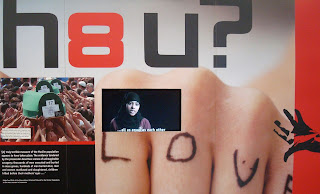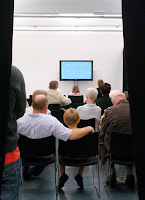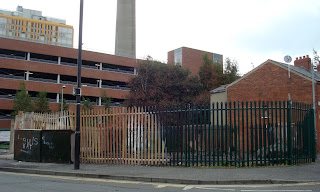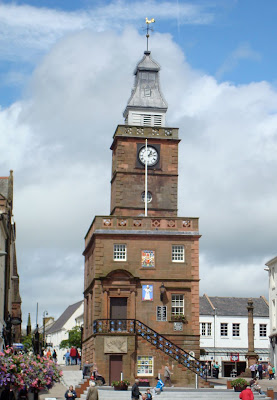
“I have always had the feeling that many people I met never really understood the issues surrounding Drumcree, remaining so distant from it, and perhaps being swayed by prejudiced viewpoints.” John Pickering, Rector of Drumcree Parish, 1983 – 2007.
Living and working through the early years of the Drumcree protests in the mid 1990s, I grew accustomed to making my way home from the centre of Belfast to Lisburn on public transport, sometimes walking up as far as the City Hospital to avoid problems at Botanic or the recently reopened Great Victoria Street station. My protest at other people’s protest was that I continued to come into work each day and didn’t leave the country and go on holiday.
In the first few years, Orangemen – joined by other loyalist groups – blocked roads in towns and cities. Disturbances escalated and trouble flared across Northern Ireland. The Renault showroom in Ballymena lost most of the cars in its forecourt when they were set on fire. Kate Adie reported from the early July warzone that centred around the Garvaghy Road in Portadown.
Many of the television pictures from that period included Drumcree Parish church in the background, set up on the hill overlooking the evermore sophisticated barriers that blocked the road. I often asked myself why the rector John Pickering continued to host the local brethren in his church on the Sunday morning before 12 July each year? In what way did the service, and the carnage around it, glorify God?
Last year, Pickering published a book simply titled Drumcree. It’s a fascinating read, and one that changed my mind about his actions and reversed my internal condemnation of what he was doing.
It’s a fascinating read, and one that changed my mind about his actions and reversed my internal condemnation of what he was doing.
Living in the middle of the action, Pickering and his family became caught up in the negotiations between Orange officials, politicians, police and residents. He describes one incident from the first year in 1995:
“At 9.00pm as the rally was concluding and before Rev. T. R. B. Taylor said a closing prayer, about a dozen unruly youths began to attack the RUC at the blockade. This lasted for about an hour. On hearing this Olive and I decided to go up to the rectory and watch from an upstairs window to get a better idea of what was happening. I saw that a group of about 250 people had entered the field beside the blockade and about 24 of them were throwing stones and missiles at the RUC and trying to make their way to the Garvaghy Road. They were soon prevented from doing so by the RUC, who fired rubber bullets.”
The annual protests took a toll on Pickering’s family life, as well as disrupting his pattern of eating and sleeping. The church didn’t escape unscathed.
“On Thursday 13th July Olive and I left for Dublin … but had to return to Drumcree the next day because … there had been a firebomb attack on the Parochial Hall and the front doors had been badly scorched.”
The Church of Ireland Synod became a place that Drumcree and the church’s involvement was regularly discussed. Pickering sought to distance “the attendance of Orangemen at services in Drumcree” from being classified as a form of sectarianism. In a speech to the May 1997 Synod he talked about the Sunday morning service.
“The Orangemen attend the service like any other people coming to worship … The stand-off at Drumcree, took place on the public road after the service and was separate from the service and the Church … What took place outside my church was going to happen somewhere in Northern Ireland and it just happened to take place at Drumcree … And do let it be remembered, that it has been said that if the stand off had not been outside Drumcree Church, but further along the road, then the influence of the Church for calm would have been absent. It has also been said, ‘The surprise about Drumcree was not how bad it was, but how mild it was and how little happened afterwards.’” [emphasis reproduced from the book’s text]
Drumcree Four in 1998 was a bloody year.
“There were about 8,000 people on Monday evening. I phoned Jonathan Powell, the Pam’s Chief of Staff, at No10 Downing Street at 1.00am on Tuesday 7th to tell him how serious the situation had become and he said he would speak to the PM. 10,000 gathered on Tuesday evening and 16,000 on Wednesday evening … the first days of the week were fairly peaceful at Drumcree. However, there was dreadful violence in many other parts of the province.”
On the Thursday evening “an unruly element infiltrated the crowd” of 20,000. Blast bombs were thrown and police officers were injured. Friday saw more trouble, and a woman student lost an eye after being hit by a plastic bullet. Yet Pickering explains that
“… there was a carnival air as people met up with old friends … partaking of the refreshments that were available in abundance from the tea, soft drinks and burger stalls. I found it very difficult to understand this, while there was so much disorder elsewhere … a parishioner said to me, ‘This would be a marvellous experience, if it was not so serious’.”
On the Sunday morning, the three Quinn brothers were murdered in an attack on a house in Ballymoney. William Bingham, then minister of Pomeroy and County Armagh Grand Chaplain “commented that no parade was worth a life” and afterwards clarified what he said “pointing out that he was not against the Drumcree parade”.
That autumn, Pickering received a letter from 160 Church of Ireland clergy asking him and his Select Vestry “to prevent Orangemen from attending morning service in July”. Four days later, the clergy released the letter to the Irish News. After another week, after talking to Select Vestry, Pickering issued a statement rejecting the clergy’s suggestion and explaining that “I will never deny the right of worship to any person including any member of the Orange Order”.
In the book he goes on to explain that “people cannot be prevented from worshipping Almighty God, it is a God given right and a human right, which cannot be denied”. He points out the absurdity of welcoming a parishioner to Sunday services 51 weeks of the year and then refusing him entry on the one week he turns up wearing a sash. Later that month, Archbishop Eames supported his position:
“It has been suggested by some people that either this service should be banned or members of the Orange Order should not be admitted. This is not the way of the Church of Ireland, which is a welcoming Church whose doors are open to all. As Archbishop I uphold that principle.”
Pickering notes irony of the words spoken by the new Archbishop Alan Harper to Pickering’s successor Rev Gary Galway at his institution as rector of Drummer in September 2008. After presented him with the key of a church, Harper said “… let the doors of this place be open to all people”. This coming from the man who proposed the 1999 General Synod Motion that Orangemen be barred from attending worship at Drumcree.
1995 turned out to be one of the quietest years. After handing over their letter of protest and being told that the parade could not continue along the road, Pickering suggested that the crowds should be asked to move off the hill and over into the rectory field for a briefing. There, Harold Gracey addressed them and “affirmed that the protest would continue and that it was to be peaceful”. The potential for tension was defused.
Towards the end of the book, Pickering reflects on his role. He didn’t run away from Drumcree. Instead he decided to stay.
“I realised that the people at Drumcree were in great distress and needed me, the rector, to help them. I saw that the Orange Order was feeling that it did not have a friend, so I decided to be that friend … I am well aware that many criticisms have been made about … their lack of discipline at times and this I would often have concurred with, but when I saw the Order in need, that was a much different matter and it required a pro-active approach.
I reflected upon the fact that the Lord Jesus Christ became incarnate and entered the world showing the utmost understanding of the needs of all people and exercising absolute compassion towards them. As I thought of how Christ mixed among needy people and helped them, I took him as my example to do the best I could for the needy people at Drumcree.”
There are still some aspects of the church’s involvement at Drumcree that I don’t agree with. But I now have a much greater understanding of how the situation looked from Pickering’s rectory window, and his consistent motivation for acting as peacemaker and broker in the midst of the chaos and hurt.
For anyone who followed the protests in the news – and perhaps still turns on the lunchtime news on Radio Ulster on the Sunday before 12 July to hear if Drumcree gets a mention – Pickering’s book is well worth a read.
is well worth a read.




































